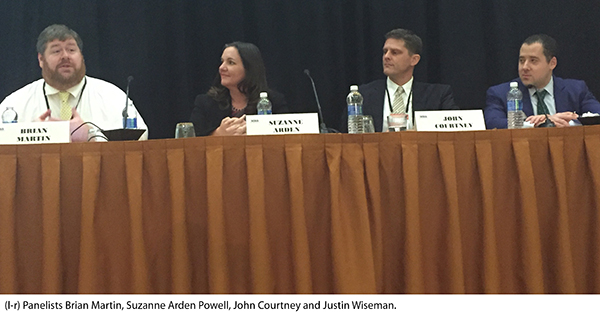
The Future of Mortgage Servicing: ‘Blockchain,’ Robotics, Job Help
DALLAS–“The beauty of predicting the future is that no one is right or wrong,” noted Justin Wiseman, director of loan administration with the Mortgage Bankers Association.
And for mortgage servicing, said Brian Martin, director of technology with Sapient Global Markets, Boston, the future is technology.
One sign of the future, Martin said here at the MBA National Mortgage Servicing Conference & Expo, is blockchain–a distributed approach to databases in which multiple clients share a technology without having the ability to corrupt or change the technology. He said blockchain technology will transform the future of the mortgage industry and mortgage servicing in particular.
 “The ability to have servicing records in blockchain will enable us to carry a history of a loan among multiple clients without having to worry about it being compromised,” Martin said.
“The ability to have servicing records in blockchain will enable us to carry a history of a loan among multiple clients without having to worry about it being compromised,” Martin said.
Blockchain will require a significant investment from the mortgage industry, “but it will pay for itself in a very short time,” Martin added.
Suzanne Arden Powell, managing director and mortgage solutions executive with IBM, Charlotte, N.C., said robotics will play an increasingly important role in mortgage servicing. She said robotic computer software has the capability to create a “virtualized full-time-employee” that can manipulate, operate and orchestrate other applications, follow business rules and even execute transactions.
“Accuracy goes way up,” Powell said. “It allows you to have this virtual workforce that is more efficient than outsourcing and has the ability for continuous improvement.”
Powell says the servicing industry is ideally suited for robotic software. “You’re looking for processes that have a high degree of manual errors, a high repetition of processes or with high risk exposure or standardized or structured data and policies,” she said. “If you have something that has tremendously high volume that isn’t going to change, this area is an ideal candidate for robotic processes.”
Powell noted that robots can be easily replicated and scaled to meet peak or atypical workloads. “They don’t sleep; they don’t eat lunch,” she said. “Robots can be up to five times faster and can work 24/7.”
But robotics also enhance the human element, Powell said. “It enhances engagement between servicers and the customer,” she said. “It’s been great for our phone agents, who have the ability to get information quickly thanks to robotic applications.
John Courtney, CEO of NextJob, Bend, Ore., said the cost of mortgage delinquencies and foreclosure continue to drive servicer losses, on average a loss of $40,000-$50,000 per loan. Using data to reduce costs is critical, he said, noting that it takes the average unemployed person at least six months to find a new job. “That six months is the difference between staying in a home and losing it,” he said.
Courtney, however, targeted the ability of borrowers to repay their loans, through jobs. He developed a process to work with unemployed borrowers to motivate them to look for work again and help them find jobs. Thus was born NextJob.
NextJob works with banks to identify borrowers who have become unemployed. It reaches out to these borrowers and provides them with employment services to find a new job, so that they could regain currency on their mortgages.
“The bank becomes the job coach,” Courtney said. “Customers tend to be surprised that their bank is so interested in helping them.”
Working with Freddie Mac, several banks, including Fifth Third, Dayton, Ohio, participated in a pilot program. In the first year, 44 percent of unemployed borrowers found a new job and got back on track with their mortgage payments–triple the rate of those who did not participate in the program.
“That’s a pretty strong ROI,” Courtney said, adding that it also saves costs in loss mitigation, foreclosure and real estate owned. “It’s that human piece that makes the difference.”
Powell agreed. “Robotics are not going to replace the human touch,” she said. “But they are going to help human employees enhance the customer experience.”
